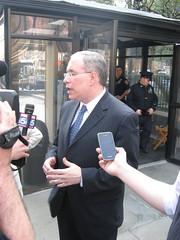N.Y.U. announced today that, after negotiations with Manhattan Borough President Scott M. Stringer, it had agreed to reduce its ambitious expansion plans on two blocks south of Washington Square Park by nearly a fifth.
The revised plan includes significant changes for all four proposed buildings and the elimination of 377,000 square feet in the project, which originally called for 2,474,000 square feet of new space.
The new plan “strikes a balance between a great university’s need to grow and the importance of preserving Greenwich Village’s distinctive, historic character,” Mr. Stringer said in a press release. “There was nothing easy about this: Everyone had to give up something. No one got everything they wanted.”
The project, dubbed N.Y.U. 2031, will now go before the City Planning Commission and then the City Council. Community Board 2 voted unanimously to oppose the plan in February.
 Stephen Rex Brown Manhattan Borough President Scott M. Stringer spearheaded negotiations with the university.
Stephen Rex Brown Manhattan Borough President Scott M. Stringer spearheaded negotiations with the university.Not surprisingly, the concessions did not satisfy opponents. “This is really just rearranging the deck chairs on the Titanic,” said Andrew Berman, the executive director of the Greenwich Village Society for Historic Preservation. “A slight decrease in the size of a few buildings does not change the fact that this massive plan is fundamentally wrong. It’s unfortunate that the Borough President was willing to give away his vote and get so little in exchange for it.”
Previously, Mr. Stringer had said he would seek to strike a balance between the needs of the university and the importance that it not overwhelm Greenwich Village. He said the revised plan did find that middle ground — though the university did not agree to all his recommendations. Most notably, it did not agree to eliminate a hotel planned for the southern corner of Bleecker Street and LaGuardia Place.
Still, in the release from Mr. Stringer’s office, opponents like Brad Hoylman, the chair of Community Board 2, and Terri Cude of the Community Action Alliance on N.Y.U. 2031 were quoted portraying the revised plan as the product of fruitful negotiations (which will almost certainly continue).
N.Y.U. President John Sexton said, “This is a good and important step, and a recognition that universities need to grow to maintain excellence and that strong universities are important to keeping our city strong.”
What N.Y.U. agreed to do:
- Reduce the height of the Mercer Building on the northern block to no more than 162 feet. The university had initially proposed a 218-foot, 14-story building.
- Reduce the combined size of the Mercer and LaGuardia buildings by 85,000 square feet.
- Not demolish the Mercer Playground to make way for new construction below city-owned land along Mercer Street. Mr. Stringer wrote that the acquisition of the strip of land, along with another one on LaGuardia Place, would lead to the destruction of trees and “widen the boundaries of the northern superblock without a clear purpose.” The strips, which currently fall under the jurisdiction of the Transportation Department, will be designated parkland.
- Not demolish Key Park to make way for a temporary gym in 2013. Instead, N.Y.U. will search for a location for the gym off-site. The playground will become a staging ground for construction sometime between 2014 to 2019.
- Move the Zipper building on the south block 15 feet back from the street in response to concerns regarding shadows.
- Cut the proposed Bleecker Building in half by eliminating seven stories of dormitories. The building would only house a public school. “The elimination of the dormitory would lessen impacts on the LaGuardia community gardens,” Mr. Stringer wrote. However, N.Y.U. officials told The Local last month that the school on its own would still enshroud the garden and kill plants.
- Not lease new retail space to bars.
What N.Y.U. did not agree to do:
- Eliminate the 115,000-square-foot hotel planned for the Zipper building. “While N.Y.U. has contended that a hotel is needed for their general purposes, the hotel does not need to be located on its core [around Washington Square Park], which should focus on academic related growth,” Mr. Stringer wrote.
- Consider redesigning the boomerang-shaped LaGuardia and Mercer buildings in response to concerns that they would enclose the north block and make it uninviting to pedestrians.
- Transfer its lease at 505 LaGuardia Place to residents, as recommended by the Community Board 2, in order to ensure that it remain an affordable building. Though Mr. Stringer did not go so far as to endorse such a transfer, he noted that the university should “work with the residents of 505 LaGuardia and relevant City agencies to reach an agreement to preserve the building’s affordability for existing and future families.”
- Restrict storefronts from being used for “destination retail” that would increase foot-traffic in the area.




